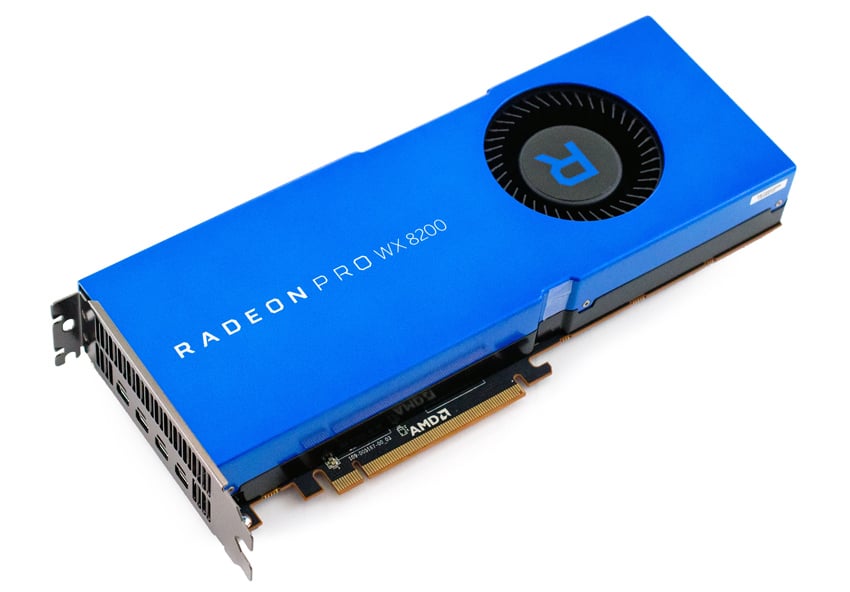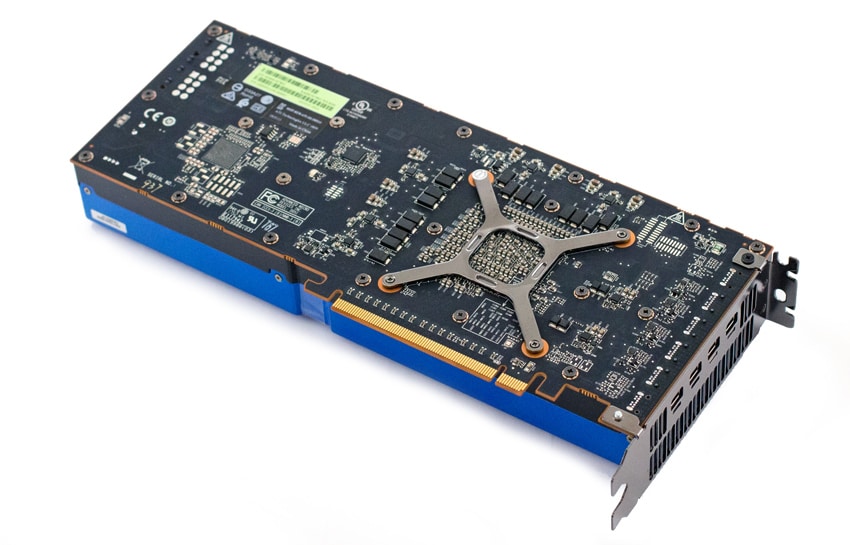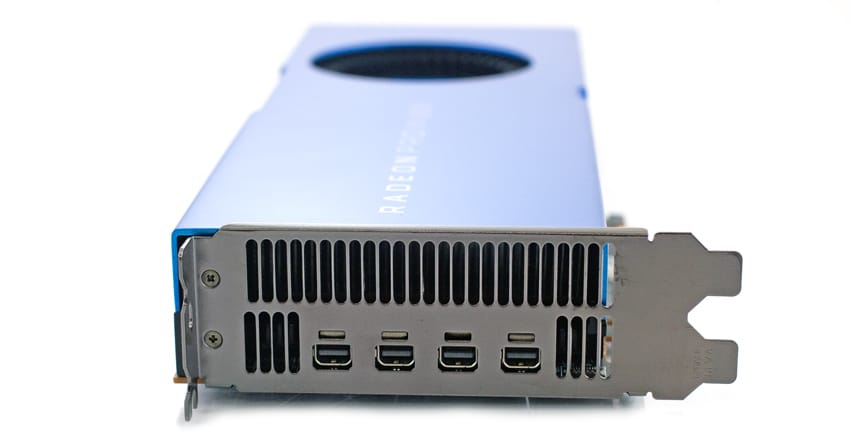 The AMD Radeon Pro WX 8200 is a GPU solution designed for professionals who work with high-end graphics applications such as design, manufacturing, media and entertainment. It is also ideal for those who do their gaming on a notebook. Last year, we looked at a range of professional graphics cards, including high-end (NVIDIA Quadro P6000), mid-range (NVIDIA Quadro P1000) to low end (Radeon Pro WX 3100) options. The WX 8200 fits nicely in the upper part of this range with its 8GB of HBM2 memory and high bandwidth controller. AMD also boldly describes their new performance-driven card as the most powerful workstation GPU under $1000, that means it claims to have a better price to performance than NVIDIA’s Quadro P4000.
The AMD Radeon Pro WX 8200 is a GPU solution designed for professionals who work with high-end graphics applications such as design, manufacturing, media and entertainment. It is also ideal for those who do their gaming on a notebook. Last year, we looked at a range of professional graphics cards, including high-end (NVIDIA Quadro P6000), mid-range (NVIDIA Quadro P1000) to low end (Radeon Pro WX 3100) options. The WX 8200 fits nicely in the upper part of this range with its 8GB of HBM2 memory and high bandwidth controller. AMD also boldly describes their new performance-driven card as the most powerful workstation GPU under $1000, that means it claims to have a better price to performance than NVIDIA’s Quadro P4000.
The AMD Radeon Pro WX 8200 is a GPU solution designed for professionals who work with high-end graphics applications such as design, manufacturing, media and entertainment. It is also ideal for those who do their gaming on a notebook. Last year, we looked at a range of professional graphics cards, including high-end (NVIDIA Quadro P6000), mid-range (NVIDIA Quadro P1000) to low end (Radeon Pro WX 3100) options. The WX 8200 fits nicely in the upper part of this range with its 8GB of HBM2 memory and high bandwidth controller. AMD also boldly describes their new performance-driven card as the most powerful workstation GPU under $1000, that means it claims to have a better price to performance than NVIDIA’s Quadro P4000.

The WX 8200 card features the new VEGA architecture with the 14nm FinFET process, allowing it to excel in design and rendering use cases, so says AMD. This technology is also highlighted by a controller that effectively leverages system memory, flash-based SSDs and new storage-class memory so it can thrive in environments with big data sets and diverse compute workloads. It also features Error Correcting Code (ECC) Memory, which helps to ensure accuracy of computations by correcting any single or double-bit error from naturally occurring background radiation.

As far as connectivity goes, the WX 8200 features four mini-DisplayPort 1.4 HDR Ready Display Outputs via its double-slot board width. There’s also plenty of ventilation on the front for its radial fan, which forces air over the card’s components then exhausts it out through the vent holes.

Radeon Pro WX 8200 Specifications
| GPU Architecture | Vega |
| Lithography | 14nm FinFET |
| Stream Processors | 3584 |
| Peak Half Precision (FP16) Performance | 21.5 TFLOPs |
| Peak Single Precision (FP32) Performance | 10.75 TFLOPs |
| Peak Double Precision (FP64) Performance | 672 GFLOPs |
| GPU Memory | Memory Size: 8 GB Memory Type (GPU): HBM2 Memory Bandwidth: 512 GB/s Memory ECC Support: Yes |
| Board Specifications Form Factor | Yes |
| Board Specifications Form Factor | PCIe Add-in Card |
| Bus Type | PCIe 3.0 x16 |
| TDP | 230W |
| Board Width | Double Slot |
| Board Length | 10.5″ |
| Board Height | Full Height |
| External Power Connectors | 1x PCIe 6-pin, 1x PCIe 8-pin |
| Display Outputs DisplayPort | 4x Mini-DisplayPort 1.4 |
| Additional Features | AMD Eyefinity Technology (Professionals) Radeon™ ProRender Radeon™ Rays Unified Video Decoder (UVD) Video Code Engine (VCE) AMD DirectGMA Technology S400 Synchronization Module Support |
| 10-bit Display Color Output | Yes |
| 3D Stereo Output | Yes |
| Other support | Software API Support DirectX: 12.0 (feature level 12_1) OpenGL: 4.5 OpenCL: 2.0 Vulkan: 1.1 |
Performance
To gauge the performance of the WX 8200, we put it through several graphics benchmarks via when populated inside the HP Z640 workstation. We will be comparing the AMD card to the NVIDIA P4000 to demonstrate the performance difference between two similarly specced cards from two different companies. We will also be comparing it to the P5000, a higher-classed card with double the GPU memory.
The first benchmark is the SPECviewperf 12, which is the worldwide standard for measuring graphics performance based on professional applications. SPECviewperf runs 9 benchmarks it calls viewsets, all of which represent graphics content and behavior from actual applications. These viewsets include 3dsmax-05, CATIA, Creo, Energy, Maya, Medical, Showcase, Siemens NX, and Solidworks. During this test, the WX 8200 posted some pretty solid numbers. Compared to the P4000, it had similar performance, though each card excelled a bit more in specific categories. For example, the WX 8200 boasted 86.68 and 117.42 in showcase and creo, respectively, whereas the P4000 had 110.06 and 82.93.
| SPECviewperf 12 | |||
|---|---|---|---|
| Viewsets | AMD Pro Radeon WX 8200 | NVIDIA Quadro P5000 | NVIDIA Quadro P4000 |
| 3dsmax-05 | 139.16 | N/A | N/A |
| catia-04 | 145.55 | 171.15 | 143.87 |
| creo-01 | 86.68 | 122.80 | 110.06 |
| energy-01 | 18.66 | 17.30 | 12.76 |
| maya-04 | 88.14 | 106.58 | 98.29 |
| medical-01 | 86.40 | 77.73 | 55.91 |
| showcase-01 | 117.42 | 102.47 | 82.93 |
| snx-02 | 149.61 | 214.56 | 156.07 |
| sw-03 | 132.21 | 188.09 | 157.43 |
Our next benchmark is SPECwpc test, which is designed for gauging all of key aspects of workstation performance. It consists of over 30 workloads related to CPU, graphics, I/O, and memory bandwidth. The workloads fall under broader categories, such as media and entertainment, financial services, product development, energy, life sciences, and general operations, which are an average of all the individual workloads in each category. As you can see, the HP Z640 outstanding results when outfitted with the AMD card:
| SPECwpc v2.0 | |||||
|---|---|---|---|---|---|
| Category | AMD Pro Radeon WX 8200 | ||||
| M&E | 4.37 | ||||
| ProdDev | 4.49 | ||||
| LifeSci | 6.31 | ||||
| Energy | 7.98 | ||||
| FSI | 11.56 | ||||
| GeneralOps | 1.41 | ||||
In our last benchmark, we will be looking at several aspects of the Esri ArcGIS Pro program; specifically, the average of the drawtime, average frames per second (Average FPS) and minimum frames per second (Minimum FPS).
| Esri ArcGIS Pro Benchmark | |
|---|---|
| Drawtime | Average |
| AMD Pro Radeon WX 8200 | 00:00:06.443 |
| NVIDIA Quadro P5000 | 00:00:06.412 |
| NVIDIA Quadro P4000 | 00:00:06.349 |
| Average FPS | Average |
| AMD Radeon WX 8200 | 382.16 |
| NVIDIA Quadro P5000 | 513.15 |
| NVIDIA Quadro P4000 | 499.66 |
| Minimum FPS | Average |
| AMD Radeon WX 8200 | 194.56 |
| NVIDIA Quadro P5000 | 278.34 |
| NVIDIA Quadro P4000 | 280.92 |
In drawtime, the WX 8200 posted 6.443 seconds, which was just slightly higher than the other two cards. The P5000 measured in at 6.412 seconds, while the P4000 recorded 6.349. In average FPS, the AMD GPU recorded an average of 382.16, which was again lower than the comparables, but still a solid result, while minimum FPS reached 194.56. The P5000 posted an average of 513.15 FPS, while showing a minimum FPS of 278.34 and the P4000 had an average of 499.66 FPS and a minimum FPS of 280.92.
Conclusion
The AMD Radeon Pro WX 8200 is a solid addition to AMD’s mid-range portfolio of professional graphics cards. Equipped with 8GB of HBM2 GPU memory and under the VEGA architecture, this dual-slot card performed well under our SPECwpc, SPECviewperf and Esri ArcGIS Pro workloads. Though it fell a bit behind NVIDIA’s P4000, a similarly-classed card, the WX 8200 is a great option that will excel in professional workloads in industries like architecture, engineering, animation, post-production and virtual reality.
At roughly $999, AMD boldly claims that this card is the world’s best workstation graphics performance under $1,000. Price claims are tough though, since original release pricing doesn’t always align with how a card is priced on the street or with sale offerings. Though it showed very impressive performance when inside our lab’s HP Z640 workstation, the similarly-classed NVIDIA P4000 outperformed the WX 8200 in many of our benchmarks. The AMD card thrived in medical and showcase applications, however, so depending on your use case, professionals should choose their graphics solutions based on their own specific usecase.
AMD Radeon Pro WX 8200 product page
Sign up for the StorageReview newsletter
